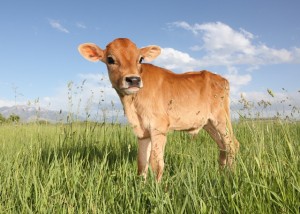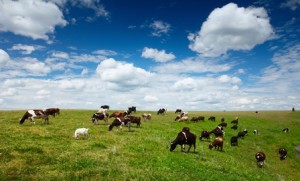Cattle Diseases
Copper Deficiency in Cattle
Also known as: Hypocupremia
Copper is an essential trace element as it is involved in many processes including red blood cell production, iron absorption from the small intestine, iron metabolism, physiological functions of the central nervous system, bone metabolism and heart function (McDowell, 1985).
Currently, debate exists as to the prevalence of copper deficiency in cattle, with some researchers considering that copper responsive disorders due to excessive molybdenum in the diet are under-diagnosed (Telfer et al., 2004). However, other researchers claim that there is insufficient evidence to support the molybdenum toxicity theory (Laven and Livesey, 2005; Suttle, 2002). This debate is on-going, but a number of well-established facts and practices are relevant to farmers.
The antagonistic trace elements and complexes
Several trace elements interfere with the absorption of copper including iron, molybdenum (Suttle et al., 1975) and sulfur (Givens and Hopkins, 1978).

Principle determinants of copper deficiency are the levels of antagonistic trace elements (Molybdenum and Sulfur) in the pasture and soil, sward maturity, rainfall, and fertilizer usage.
- Improving the pasture increases quantities of these elements, molybdenum through the application of lime, and sulfur through the increase of protein in the pasture (Whitelaw et al., 1979).
- At soil pH values below 6.5, the availability of molybdenum (Mo) is reduced and copper is increased. But low soil Mo can lead to poor clover establishment, and the sward can be dominated by grass species which accumulate Mo.
- Well drained pastures tend to have a lower copper content (MacNaeidhe, 2001). Molybdenum and sulfur, together with iron, also decrease copper availability through soiling of the pasture (Suttle et al., 1975).
Thus, rather than the copper content of the soil or herbage, the principal determinants of copper deficiency in grazing cattle, are soil molybdenum, soil pH (high values encourage Mo uptake), sward maturity, rainfall, fertilizer use and soil ingestion.
Feedstuffs vary considerably in the amount of copper they contain and its availability once eaten:
- Fresh grass is a poor source of copper, particularly in autumn and winter when it becomes contaminated with iron from soil
- Hay made from mature grass swards with lower protein levels, contains less sulfur, and thus more copper is available to the animals. Molybdenum also has less effect on the availability of copper in hay
- Silage is usually a good source of available copper unless it is contaminated with soil or preserved with sulfuric acid (Suttle, 1992a)
- Distillers grains may have a higher copper content due to copper uptake during distillery processing

Copper deficiency seems to be a heritable characteristic with Jerseys found to have higher liver copper concentrations, and therefore are potentially more susceptible to copper deficiencies.
Copper metabolism is a heritable characteristic, with some cattle breeds more susceptible to copper deficiency than others. Du et al (1996) found that Jerseys had higher liver concentration of copper, and are therefore more susceptible to copper toxicity (Du et al., 1996). In a US study it was reported Hereford-sired heifers have lower plasma concentrations than Piedmontese-sired heifers, indicating that sire breed effects plasma copper concentrations (Grings et al., 1999).
Clinical Signs of Copper Deficiency
A shortage of absorbable copper leads to a rapid depletion of liver stores and a drop in plasma copper levels. There is a lowering of caeruloplasmin synthesis (around 90% of plasma copper is found as caeruloplasmin) and a reduction in cuproenzyme activities in the erythrocytes and tissues (Suttle, 1992).
The severity of signs associated with copper deficiency in cattle depends upon the rate and stage of development at which it occurs. In the growing calf, loss of hair color, growth retardation and changes in the metatarsal conformation are the earliest signs of a deficiency, followed by diarrhea and finally anemia (Suttle, 1992a). Copper deficiency has also been associated with reduced immune cells activity such as B cells (Cerone et al., 1998; Gengelbach et al., 1997) and neutrophil function, (Cerone et al., 1998, 2000; Gengelbach and Spears, 1998; Gengelbach et al., 1997; Torre et al., 2008). The relationship between copper deficiency and infertility in cattle is mostly anecdotal and not wholly substantiated by research (Phillippo et al., 1982; Whitaker, 1982). Copper deficiency may be a greater problem in beef herds than in dairy herds (Davies and Baker, 1974) especially in beef heifers, which may have been reared on a low plane of nutrition and have increased metabolic demands in the periparturient period for both growth and pregnancy (Suttle, 2003).

Copper deficiency may be a greater problem in pregnant beef heifers that have been reared on a low plane of nutrition due to increased metabolic demands.
Diagnosis of Copper Deficiency
Diagnosis of copper deficiency can be difficult as clinical signs are often not exclusive or typical, and there is a homeostatic control mechanism which maintains plasma copper concentrations at a steady state by drawing on liver reserves. Therefore, deficiency must be marked before liver stores are reduced and blood copper concentrations fall (Suttle, 2004). Some researchers suggest the use of marginal values (Suttle, 2004, 2002), whereby if the mean blood copper concentration of a group of animals falls into the marginal band, supplementation should be considered. When using blood samples to diagnose copper deficiency, plasma values are probably better to use, as copper is lost from serum during the clotting process (Laven and Livesey, 2005).
An alternative method of diagnosis is to look at liver copper concentrations either from biopsy samples, or from culled animals or from livers obtained from the abattoir. However, before undertaking extensive sampling for trace elements, infection (parasitic or microbial) and malnutrition should be ruled out of any differential diagnosis list for a non-specific disorder such as ill-thrift or poor fertility (Suttle, 2003). Definitive diagnosis can only be obtained by unequivocal responses to trace element supplementation in a group of animals when compared to a control group managed in the same conditions.
Control and Prevention of Copper Deficiency
Management improvements that can minimize the risk of copper deficiency include minimizing liming applications and avoiding using sulfuric acid for the conversion of silage. Also allowing intermittent access to unimproved fields containing low molybdenum pasture and conserving rather than grazing herbage from fields rich in molybdenum. Minimizing the contamination of pasture with soil over winter is also helpful (Whitelaw et al., 1979). The inclusion of grass and herb species, such as clover, which contain high levels of trace elements in to the sward can usefully increase trace element intake (MacNaeidhe, 2001).
Serial copper injections are not a preferred option as a sustainable farming practice as there are alternatives available. For instance the use of cupric oxide particles in capsules given orally. The particles become lodged in the abomasum for several months and slowly release absorbable copper (Suttle, 1981). Another popular method is the use of slow release boluses (i.e., All-Trace, Agrimin; Cosecure, Telsol) containing several minerals including copper (Hemingway et al., 1997). These slowly dissolve in the reticulo-rumen and release copper on a continuous basis. Care should be taken when administering boluses to young calves, not to cause physical damage. Boluses and cupric oxide particles are very useful under extensive grazing conditions (Steffen et al., 1997).
During periods of supplementary feeding or housing, copper salts can be used to supplement forage or cereals (Suttle, 1992). Many low-input farmers use free-access minerals successfully. However, they should be aware that intakes may be variable.
Treating Copper Deficiency
The most immediate response to symptoms of copper deficiency is obtained by experimental supplementation (e.g.by bolus) once it has been established that the risk of copper poisoning is low.
Good Practice based on Current Knowledge
- Establish whether or not the soil and the complete ration are deficient in copper or contain high levels of potentially antagonistic compounds such as iron, sulfur or molybdenum
- Establish whether copper deficiency is the reason for poor calves, infertility/subfertility why in the herd by elimination of other management factors or disease conditions such as low energy provision or high parasite burdens (Suttle, 2003)
- Improve pastures in severely copper deficient areas by incorporating species into the sward (e.g. legumes) which contain a higher level of minerals, including copper
- Include trace element status monitoring and provision as part of the Herd Health Plan, including taking regular forage analyses and potentially testing animals


 British English
British English

Comments are closed.